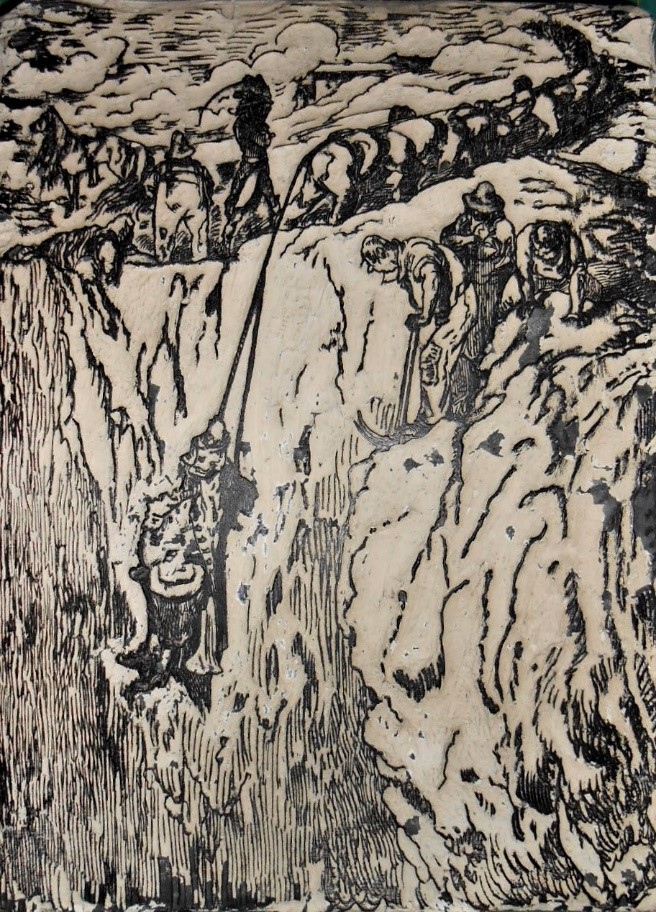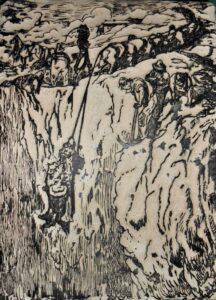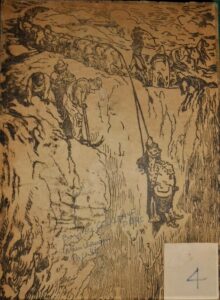Gustave Doré (1832-1883). [Ils amenèrent d’abord le domestique.] Original engraved wood signed ” G Doré ” for one of the 31 full-page plates of Aventures du baron de Münchhausen. Traduction nouvelle par Théophile Gautier fils, illustrées par Gustave Doré. Paris, Charles Furne, [1862], p. 39. Wood dimensions : 20,5 x 15 cm. With, on the ink-stained slice, ” E. T.” as well as “1” engraved and an old glued label encrypted “6 ” in ink.
Gustave Doré’s engraved woods are extremly rare, especially in this large format.
On the back, the corresponding ingraving is pasted to allow printers to locate themselves. This with in blue pen the words “Bois de Gustave Doré pour Munchausen Page 46 “, as well as a square of cipher glued paper “4 “.
Münchhausen, sort of German Tartarin, participates in a hunting party with his wife, his lieutenant and a servant. These fall into a mine shaft and will be extracted by a troop of miners., represented here as a multitude of slaves hoisting the servant, under the Münchhausen’s whip, as a biblical troop of slaves under Pharaoh, “funnily caricatured” scene, real “buffoonery”.
When he makes this wood, around 1862, the artist is at the top of his art. He illustrates the Tales by Perrault, between the Divine Comedy published last year, and Don Quichotte the following year. In the preface to the Aventures du baron de Münchhausen, Theophile Gautier praises the illustration of Gustave Doré : “nonbody better than this artist, who seems to have that visionary eye that Victor Hugo is talking about in his poem à Albert Dürer, does not know how to make life mysterious and profound the chimeras, dreams, nightmares, elusive shapes drowned in light and shadow; drôlatically caricatured silhouettes, and all the monsters of fantasy […] It looks like that, expedition painter, he has sketches by nature everything described by the mischievous German baron, and the text acquires an even more Germanic cold buffoonery value. He is really, in the beautiful expression of Jean Adhémar, “the king of illustrators (du) Romantisme Second Empire “.
The engraving of this wood was entrusted to the talented chisel of François Pannemaker (Brussels, 1822 – Paris, 1900), one of Gustave Doré’s leading engravers, but also illustrations of Erckmann-Chatrian’s novels, and Voyages extraordinaires by Jules Verne at Hetzel. Further, he’ll ingrave in 1863 few French banknotes such as the 100 francs blue, then in 1869, the twenty-franc Belgian banknote. Professor of woodcutting at the Imperial School of Drawing (the future National Graduate School of Decorative Arts), he exhibited in 1855 and was member of the jury in the woodcut section of the first International Exhibition of White and Black in Paris at the Flore Pavilion. In 1889, he was awarded a grand prize at the World’s Fair in Paris.
The backs were formerly whited in order to better distinguish the illustration.
H. Leblanc, Catalogue de l’œuvre complet de Gustave Doré, Paris, Bosse, 1931, pp. 37-38 ; G. Vicaire, Manuel de l’Amateur de Livres du XIXth century, I, 160 ; E. Benezit, Dictionnaire des peintres, sculpteurs, dessinateurs et graveurs, . 1976, III, 640-642 [about Doré, cited work], and VIII, 107 [about Pannemaker].
Sold


